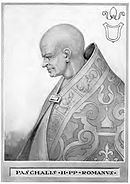Date 13 August 1099 | ||
 | ||
Winner Pope Paschal II Other Instances Papal conclave - 1799–1800, Papal conclave - 1774–75, Papal conclave - 1769, Papal conclave - 1758, Papal conclave - 1740 | ||
The papal election of 13 August 1099 took place upon the death of Pope Urban II, the cardinal-electors with the consent of the lower Roman clergy chose Pope Paschal II as his successor.
Contents
Death of Urban II
Urban II died in Rome on 29 July 1099 - two weeks before the soldiers of the First Crusade won Jerusalem, however, news of which arrived in Rome after his death. During this time, the schism initiated by Antipope Clement III, with the support of the Empire and much of the Roman clergy, was ongoing.
Cardinal-electors
The election in 1099 was probably the last which was compliant with preference of cardinal-bishops as contained in the papal bull, In nomine Domini of 1059. It is known, however, that the cardinal-priests and cardinal-deacons also participated.
Cardinal-bishops
The election was attended by five of the six cardinal bishops and one bishop, who acted as a substitute for the Cardinal Bishop of Sabina. This office was vacant from 1094 years, and the territory of the Diocese of Sabina supporters controlled the antipope Clement III.
Other cardinals
In August 1099, in obedience Urban II was only ten cardinal-priests and three cardinal-deacons, but probably no more than seven cardinal-priests and three cardinal-deacons participated in the election:
The cardinal-deacons present were probably the Palatine deacons, assistants to the Pope whose Cathedra is located in the Archbasilica of St John Lateran, which numbered up to six deacons. The twelve regional deacons joined the rank of cardinals only under Paschal II.
Absent
One cardinal-bishop and at least three cardinal-priests were absent during the election.
Cardinal-bishops
Cardinal-priests
Election of Paschal II
On 13 August 1099 the cardinals in the presence of the lower clergy and representatives of the city authorities unanimously elected Ranieirus, the cardinal-priest of San Clemente and abbot of the Basilica of Saint Lawrence outside the Walls as successor to Urban II. The new pope initially protested against this decision, stating that he was only a humble monk unfamiliar with the political problems attached to the office of Pope, but relented and accepted their decision. He took the Papal name Paschal II. On the next day he was consecrated Bishop of Rome by Cardinal-bishop of Ostia Eudes of Chatillon, who was assisted by other Cardinal-bishops and Offo, Cardinal-bishop of Nepi.
